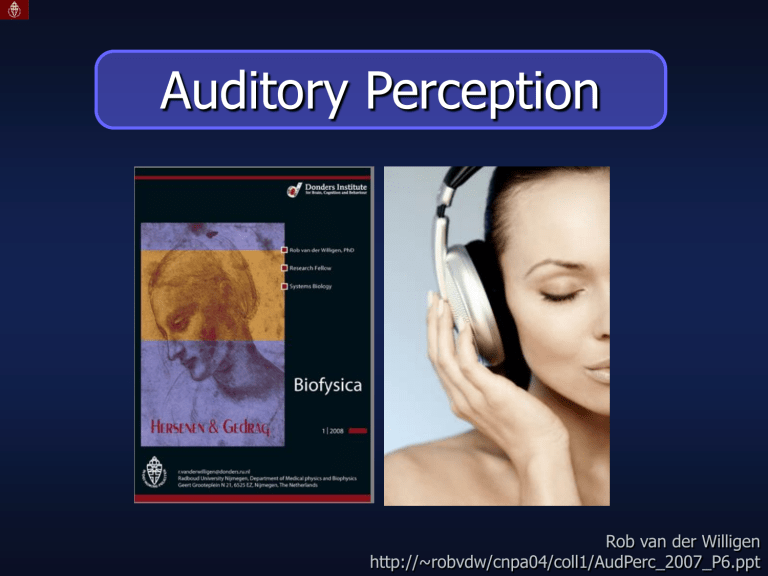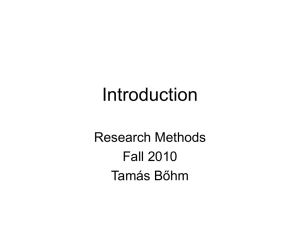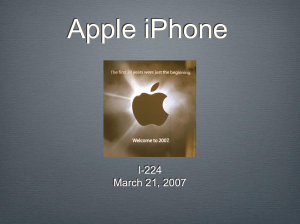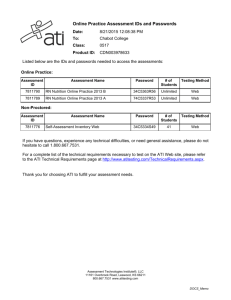Loudness
advertisement

Auditory Perception Rob van der Willigen http://~robvdw/cnpa04/coll1/AudPerc_2007_P6.ppt Q uickTim e™and aTI FF( LZW) decompr essor ar e n eededt o seet his pictur e. Today’s goal Understanding the perceptual scaling of sound intensity: LOUDNESS Q uickTim e™and aTI FF( LZW) decompr essor ar e n eededt o seet his pictur e. Magnitude versus Loudness Magnitude estimation treats the perceiver as a measuring instrument capable of assigning numbers to sounds in proportion to their loudness. Equal loudness contours summarize the intensity levels that make tones of different frequencies sound equal in loudness. Q uickTim e™and aTI FF( LZW) decompr essor ar e n eededt o seet his pictur e. Magnitude versus Loudness Loudness is a subjective impression of the intensity of sound Loudness matching is adjusting the loudness of one sound until it is equivalent to the loudness of another Q uickTim e™and aTI FF( LZW) decompr essor ar e n eededt o seet his pictur e. Humans versus the rest Psychoacoustics Q uickTim e™and aTI FF( LZW) decompr essor ar e n eededt o seet his pictur e. Physical Dimensions of Sound Amplitude - height of a cycle - relates to loudness Wavelength (λ) - distance between peaks Phase (j ) - relative position of the peaks Frequency (f ) - cycles per second - relates to pitch Psychoacoustics Q uickTim e™and aTI FF( LZW) decompr essor ar e n eededt o seet his pictur e. Acoustic Units of Sound Measurement Psychoacoustics Q uickTim e™and aTI FF( LZW) decompr essor ar e n eededt o seet his pictur e. Physical parameters of sound waves: Sound Intensity Sound Intensity (I) of a wave is the rate at which sound energy flows through a unit area (A) perpendicular to the direction of travel: Intensity Pressure Particle Velocity Force Distance Energy Area Time Area Time Power P[w] Area A[m 2 ] Sound Pressure, P, is measured in watts [W=J/s] A is measured in square meters [m2] Psychoacoustics Q uickTim e™and aTI FF( LZW) decompr essor ar e n eededt o seet his pictur e. Sound Intensity: The Decibel scale Sound Intensity Level: Intensity threshold of hearing I0 = 10-12 W/m2 Sound Pressure Level: Pressure threshold of hearing P0 = 2 x 10-5 N/m2 = 20 mPa Energy ratio I dB(SIL) 10log 10 I 0 Pressure ratio 2 P P dB( SPL) 10 log 10 20 log 10 P0 P0 Psychoacoustics Q uickTim e™and aTI FF( LZW) decompr essor ar e n eededt o seet his pictur e. How does an acoustic sound level depend on distance from the source? Intensity (and pressure) is inverse proportional for free field propagation. At a distance 2r from the source, the area enclosing the source is 4 times as large as the area at a distance r. NB. The power radiated remains the same irrespective of the distance; consequently the intensity, the power per area, must decrease. Psychoacoustics Q uickTim e™and aTI FF( LZW) decompr essor ar e n eededt o seet his pictur e. Sound Intensity: Inverse square law Sound intensity and the inverse square law A doubling of distance from the sound source in the direct field will reduce the "sound level” by 6 dB. I 1 / I 2 = r2 2 / r1 2 I 1 r2 That is, sound intensity level, I, decreases by 6 dB per doubling of distance from the source to 1/4 (25 %) of the sound intensity initial value. This will reduce the sound intensity I (energy quantity) to 1/2² = 1/4 (25 %) and the sound pressure p (field quantity) to 1/2 (50 %) of the the initial value. Psychoacoustics Q uickTim e™and aTI FF( LZW) decompr essor ar e n eededt o seet his pictur e. Sound Pressure: 1/r law Sound pressure p and the inverse distance law 1/r In acoustics, the sound pressure of a spherical wave front radiating from a point source decreases by 50% as the distance r is doubled, thus measured in dB it decreases by 6.02 dB. The behavior is not inverse-square, but is inverse-proportional (blue-line). Sound pressure decreases inversely as the distance increases with 1/r from the sound source. Psychoacoustics Q uickTim e™and aTI FF( LZW) decompr essor ar e n eededt o seet his pictur e. Inverse square law versus Inverse distance law The inverse square law 1/r2 shows the distance performance of energy quantities. This relates to sound intensity or density. The inverse distance law 1/r shows the distance performance of field quantities. This relates to sound pressure / particle velocity / particle displacement. Energy quantities are proportional to squared field quantities: Ip 2 Psychoacoustics Q uickTim e™and aTI FF( LZW) decompr essor ar e n eededt o seet his pictur e. The Physical Relationship between Intensity (I) & Pressure (po) p02 1 I p02 r n 2 z ris mass density or air 1.204 kg/m3 at 20o Celsius. nis speed or air, 343.2 m/s, p0 zero-to-peak pressure amplitude. z is acoustic impedance or air 413.2 kg/(s·m2) or 413.2 N·s/m3. 2 I 2p Ip 2 2 2 I rms Ip n n 1 2 Ip Psychoacoustics Q uickTim e™and aTI FF( LZW) decompr essor ar e n eededt o seet his pictur e. The Decibel scale Since sound measuring instruments respond to sound pressure the "decibel" is generally associated with sound pressure level. Sound pressure levels quantify in decibels the intensity of given sound sources. Sound pressure levels vary substantially with distance from source, and also diminish as a result of intervening obstacles and barriers, air absorption, wind and other factors. Sound Pressure Level (SPL): 20 × log(p/p0) = 10 × log(p/p0)², where p0 = 2×10-5 N/m2. p = root mean square sound pressure (N/m2) The usual reference level p0 is 20×10-6 N/m2. Psychoacoustics Q uickTim e™and aTI FF( LZW) decompr essor ar e n eededt o seet his pictur e. The Decibel scale "Threshold of audibility'' or the minimum pressure fluctuation detected by the ear is less than 10-9 of atmospheric pressure or about 20×10-5 N/m2 (pascal) at 1000 Hz. "Threshold of pain'' corresponds to a pressure 106 times greater, but still less than 1/1000 of atmospheric pressure. Because of the wide range, sound pressure measurements are made on a logarithmic scale (decibel scale). Sound power levels are connected to the sound source and are independent of distance. Sound powers are indicated in decibel. Lw = 10 × log (P / P0) where: P0 = reference power (W). The usual reference level is 10-12 W, calculated from p0 = 20 micropascal, which is the lowest sound persons of excellent hearing can discern. Sound power is measured as the total sound power emitted by a source in all directions in watts (joules / second). Sound power levels do not vary with distance from source. Psychoacoustics Q uickTim e™and aTI FF( LZW) decompr essor ar e n eededt o seet his pictur e. The Decibel scale NB. 1 Pa = 1 N/m2 ≡ 94 dB 1 bar = 105 Pa Psychoacoustics Q uickTim e™and aTI FF( LZW) decompr essor ar e n eededt o seet his pictur e. The Decibel scale Psychoacoustics Q uickTim e™and aTI FF( LZW) decompr essor ar e n eededt o seet his pictur e. The Decibel scale 0 dB = Threshold of Hearing ≡ TOH 10 dB = 10 times more intense than TOH 20 dB = 100 times more intense than TOH 30 dB = 1000 times more intense than TOH An increase in 10 dB means that the intensity of the sound increases by a factor of 10 If a sound is 10x times more intense than another, then it has a sound level that is 10 times x more decibels than the less intense sound An increase of 6 dB represents a doubling of the sound pressure An increase of about 10 dB is required before the sound subjectively appears to be twice as loud. The smallest change of the pressure level we can hear is about 3 dB Psychoacoustics Q uickTim e™and aTI FF( LZW) decompr essor ar e n eededt o seet his pictur e. Counting Decibels Sound Intensity level of super imposed sources: L1 10 SIL.[dB] 10log(10 10 L2 10 LN 10 10 ) 10log 10 N 1 where L1, L2, …, Ln are SIL [dB] LN 10 Psychoacoustics Q uickTim e™and aTI FF( LZW) decompr essor ar e n eededt o seet his pictur e. Sound Density When dealing with noises, it is advantageous to use density instead of sound intensity e.g., the sound intensity within a bandwidth of 1 Hz. The logarithmic correlate of the density of sound intensity is called sound intensity density level, usually shortened to density level, LE. LE SIL 10log10(f /Hz)[dB] For white noise, l and SIL are related by the equations given above where Δf represents bandwidth of the sound. I SIL 10log 10 [ dB] I 0 Psychoacoustics Q uickTim e™and aTI FF( LZW) decompr essor ar e n eededt o seet his pictur e. Physical parameters of sound waves: Noise Density sound intensity density level E LE 10 log 10 [ dB] E 0 sound energy density E E 0 10 LE 10 [J / m 3 ] pJ 12 J E 0 1 3 10 3 m m Psychoacoustics Q uickTim e™and aTI FF( LZW) decompr essor ar e n eededt o seet his pictur e. Physical parameters of sound waves: Power Spectrum Density The Intensity Density Level of three types of NOISES: Intensity density level [dB] WHITHE NOISE BROWN (RED) NOISE Log Frequency [Hz] GRAY NOISE Psychoacoustics Q uickTim e™and aTI FF( LZW) decompr essor ar e n eededt o seet his pictur e. Physical parameters of sound waves: Power Spectrum Density Power Spectral Density (PSD) is the frequency response of a random or periodic signal. PSD shows the strength of the variations per unit frequency as a function of frequency. The PSD is the average of the Fourier transform magnitude squared, over a large time interval. It tells us how the average intensity is distributed as a function of frequency. Plot shows de PSD of white Noise Psychoacoustics Q uickTim e™and aTI FF( LZW) decompr essor ar e n eededt o seet his pictur e. THE BELL DECODER Psychoacoustics Q uickTim e™and aTI FF( LZW) decompr essor ar e n eededt o seet his pictur e. Auditory sensitivity: Absolute thresholds MAF Minimum Audible Field thresholds sound pressure level for pure tone at absolute threshold in a free field tested in a room, using loudspeakers, listening binaurally, 1 meter from source SPL calibrated using microphone, with listener not present. MAP Minimum Audible Pressure thresholds SPL at listener’s tympanic membrane sound presented over headphones (monaural) SPL estimated from the sound level in a test coupler attached to earphone. Differences in the two measures are due to some binaural advantage, outer-ear filtering (mid frequencies), and physiological noise (low frequencies). Psychoacoustics Q uickTim e™and aTI FF( LZW) decompr essor ar e n eededt o seet his pictur e. Auditory sensitivity: Absolute thresholds Differences in the two measures are due to some binaural advantage, outer-ear filtering (mid frequencies), and physiological noise (low frequencies). Psychoacoustics Q uickTim e™and aTI FF( LZW) decompr essor ar e n eededt o seet his pictur e. Auditory sensitivity: Hearing range (MAF) Psychoacoustics Q uickTim e™and aTI FF( LZW) decompr essor ar e n eededt o seet his pictur e. Auditory sensitivity: upper limit Psychoacoustics Q uickTim e™and aTI FF( LZW) decompr essor ar e n eededt o seet his pictur e. Auditory sensitivity: Absolute thresholds Hearing Level (dB HL) Threshold of hearing, relative to the average of the normal population. For example, the average threshold at 1 kHz is about 4 dB SPL. Therefore, someone with a threshold at 1 kHz of 24 dB SPL has a hearing level of 24 - 4 = 20 dB HL. Audiograms Audiograms measure thresholds in dB HL, and are plotted “upsidedown”. Measurements usually made at octave frequencies from 250 Hz to 8000 Hz. Threshold microstructure Individuals show peaks and dips as large as 10 dB over very small frequency differences (probably due to OHCs and “cochlear amplifier”). Psychoacoustics Q uickTim e™and aTI FF( LZW) decompr essor ar e n eededt o seet his pictur e. Auditory sensitivity: Audiometric curve (audiogram) Plot A shows the threshold of hearing or audibility curve for a patient with a hearing loss (curve b) and a normal curve (curve a). Notice that the patient's threshold is higher for every frequency above 128 Hz. The normal audibility curve is usually converted to a straight line at 0 dB loss, and the patient's values are plotted as deviations from the normal values. The result is a hearing loss curve b, as shown in plot B. Psychoacoustics Q uickTim e™and aTI FF( LZW) decompr essor ar e n eededt o seet his pictur e. Auditory sensitivity: Audiometric curve (hearing loss) Psychoacoustics Q uickTim e™and aTI FF( LZW) decompr essor ar e n eededt o seet his pictur e. Auditory sensitivity: Audiometric curve (hearing loss) Conduction loss stems from damage to outer or middle ear (areas involved in conduction of sound energy to the inner ear). Sensory/neural loss is associated with damage to the inner ear or auditory cortex. Psychoacoustics Q uickTim e™and aTI FF( LZW) decompr essor ar e n eededt o seet his pictur e. Auditory sensitivity: Audiometric curve (hearing loss) Blue lines in the audiogram indicate the hearing loss as measured by air conduction, whereas pink lines indicate the hearing loss as measured by bone conduction. Typically, in neural hearing loss (A), both measures show the same pattern of loss. Surgery is not indicated for this form of hearing loss because the neural tissue probably cannot be repaired, but some improvement in hearing is possible with a hearing aid, depending upon the nature of the damage. The audiogram of a person with pure conduction hearing loss (B). Here, bone conduction (pink) is near normal, i.e., near 0 dB loss, but air conduction is impaired (blue). Notice that the air audiogram is nearly flat with conduction hearing loss (B, pink), but there is a differential loss, depending upon frequency, in nerve hearing loss (B, blue). Psychoacoustics Q uickTim e™and aTI FF( LZW) decompr essor ar e n eededt o seet his pictur e. Absolute thresholds: temporal integration Audiometric thresholds and international threshold standards are measured using long-duration tones (> 500 ms). Detectability of tones with a fixed level decreases with decreasing duration, below 300 ms. IL is the minimum intensity which is an ( I I L ) t I Lt I t I L 1 I L t effective long duration stimulus for the ear. t represents the integration time of the auditory system. Thus, the auditory system does not simply integrate stimulus time (Intensity x duration) It may also vary with frequency. Psychoacoustics Q uickTim e™and aTI FF( LZW) decompr essor ar e n eededt o seet his pictur e. Absolute thresholds: temporal integration The absolute threshold for detecting sounds is affected by duration Up to a few hundred milliseconds the threshold for detecting sounds decreases (more sensitive) with increasing duration Effect of duration on loudness causes variability in the results For a given intensity, loudness increases with duration up to 100-200ms ( I I L ) t I Lt I t I L 1 I L t Psychoacoustics Q uickTim e™and aTI FF( LZW) decompr essor ar e n eededt o seet his pictur e. Perceived Loudness: Equal-loudness Contours The pressure, or intensity, of a sound wave is not solely responsible for its loudness – frequency is also important. 1 kHz is used as a reference. By definition, a 1-kHz tone at a Intensity level of 40 dB SPL has a loudness level of 40 phons. Any sound having the same loudness (no matter what its SPL) also has a loudness level of 40 phons. Equal-loudness contours are produced using loudness matching experiments (method of adjustment or method of constant stimuli). Equal-loudness contours Psychoacoustics Q uickTim e™and aTI FF( LZW) decompr essor ar e n eededt o seet his pictur e. SPL is not a measure of Perceived Loudness Loudness is defined as the attribute of auditory sensation in terms of which sounds can be ordered on a scale extending from quiet to loud. Two sounds with the same sound pressure level may not have the same (perceived) loudness A difference of 6 dB between two sounds does not equal a 2x increase in loudness Loudness of a broad-band sound is usually greater than that of a narrow-band sound with the same (physical) power (energy content) Psychoacoustics Q uickTim e™and aTI FF( LZW) decompr essor ar e n eededt o seet his pictur e. Perceived Loudness: Equal-loudness Contours The pressure, or intensity, of a sound wave is not directly related to its loudness – frequency is also important. Psychoacoustics Q uickTim e™and aTI FF( LZW) decompr essor ar e n eededt o seet his pictur e. Perceived Loudness: phone A unit of LOUDNESS LEVEL (L) of a given sound or noise can only be derived from indirect loudness measurements (see e.g., the Fletcher and Munson experiment) If SPL at reference frequency of 1kHz is X dB – the corresponding equal loudness contour is X phon line. Phon units can’t be added, subtracted, divided or multiplied. 60 phons is not 3 times louder than 20 phons! The sensitivity to different frequencies is more pronounced at lower sound levels than at higher. For example: a 50 Hz tone must be 15 dB higher than a 1 kHz tone at a level of 70 dB Psychoacoustics Q uickTim e™and aTI FF( LZW) decompr essor ar e n eededt o seet his pictur e. Perceived Loudness: sound level meters The shapes of equal-loudness contours have been used to design sound level meters (audiometer). At low sound levels, low-frequency components contribute little to the total loudness of a complex sound. Thus an A weighting is used to reduces the contribution of lowfrequencies. Psychoacoustics Q uickTim e™and aTI FF( LZW) decompr essor ar e n eededt o seet his pictur e. Perceived Loudness: A-weighting & sound level meters A-weighting is only really valid for relatively quiet sounds and for pure tones as it is based on the 40-phon Fletcher-Munson curves which represented an early determination of the equal-loudness contour for human hearing. Nevertheless, A-weighting would be a better match to the loudness curve if it fell much more steeply above 10 kHz, and it is likely that this compromise came about because steep filters were difficult to construct in the early days of electronics. Nowadays, no such limitation need exist. If A-weighting is used without further band-limiting it is possible to obtain different readings on different instruments when ultrasonic, or near ultrasonic noise is present. Accurate measurements therefore require a 20 kHz low-pass filter to be combined with the A-weighting curve in modern instruments. This is defined in IEC 61672 as A-U weighting and while very desirable, is rarely fitted to commercial sound level meters. Psychoacoustics Q uickTim e™and aTI FF( LZW) decompr essor ar e n eededt o seet his pictur e. Perceived Loudness: Masking Auditory masking occurs when background noise makes sound inaudible. Broadband noise is contains energy at all audible frequencies. Bandpass noise removes energy from the low- and highfrequency ends of the spectrum. Psychoacoustics Q uickTim e™and aTI FF( LZW) decompr essor ar e n eededt o seet his pictur e. Loudness Scaling: Magnitude of perceptual change I dI dS 1 1 k dI I I/I constant Fechner assumed that a JND for a faint reference sound produces the same difference in sensation as does the JND for a loud reference. Measure of loudness: sensation intensity (S) in JND units As it turned out, this assumption is not valid, as shown by Stevens (1957) he simply asked subject to asses supra-threshold stimuli. Psychoacoustics Q uickTim e™and aTI FF( LZW) decompr essor ar e n eededt o seet his pictur e. Louness Scaling: Stevens’ Power law Another function relating Loudness S in sones to stimulus intensity in I: S aI =0.3 m The exponent m describes whether sensation is an expansive or compressive function of stimulus intensity. The coefficient a simply adjusts for the size of the unit of measurement for stimulus intensity threshold above the 1-unit stimulus. Psychoacoustics Q uickTim e™and aTI FF( LZW) decompr essor ar e n eededt o seet his pictur e. Auditory sensitivity: JND Smallest detectable change in sound level equals 0.3-2dB for a wide range of levels and types of sound A value of 0.5-1dB for wideband noise – holds from about 20dB to 100dB above threshold – JND increases for sounds close to absolute threshold For pure tones the JND for loudness varies slightly with frequency (best 1-4 kHz) and may improve at higher sound levels Psychoacoustics Q uickTim e™and aTI FF( LZW) decompr essor ar e n eededt o seet his pictur e. Loudness Scaling Psychoacoustics Q uickTim e™and aTI FF( LZW) decompr essor ar e n eededt o seet his pictur e. Loudness Scaling: sone vs. phon SONE: a unit to describe the comparative loudness between two or more sounds. One SONE has been fixed at 40 phons at any frequency (40 phon curve). 2 sones describes sound two times LOUDER than 1 sone sound. A difference of 10 phons is sufficient to produce the impression of doubling loudness, so 2 sones are 50 phons. L k ( p p0 ) 4 sones are twice as loud again, viz. 60 phons. 0.6 p is the base pressure of a sinusoidal stimulus, po is its absolute threshold. Psychoacoustics Q uickTim e™and aTI FF( LZW) decompr essor ar e n eededt o seet his pictur e. Predicting Loudness Currently, predictors of loudness are only successfully for sound stimuli extending over many seconds. Note that the dBA scale does not include bandwidth influences on loudness (etc.). It is better than the dB SPL scale, but far away from human perception Psychoacoustics Q uickTim e™and aTI FF( LZW) decompr essor ar e n eededt o seet his pictur e. Neural Coding of Loudness Neural Coding related to the perception of loudness: Increase in sound level: increased BM movement leads to increased firing rates in the neurons of the auditory nerve spread of activity to adjacent neurons the summation of neural activity across different frequency channels – critical bands Psychoacoustics Q uickTim e™and aTI FF( LZW) decompr essor ar e n eededt o seet his pictur e. Neural Coding of Loudness Individual neurons are sensitive to a limited range of intensities (blue vs red) But different neurons are responsive to different intensity ranges Neurons respond to nonpreferred frequencies at high enough intensities





